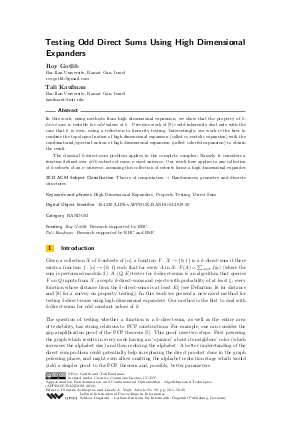Testing Odd Direct Sums Using High Dimensional Expanders
Authors Roy Gotlib, Tali Kaufman
-
Part of:
Volume:
Approximation, Randomization, and Combinatorial Optimization. Algorithms and Techniques (APPROX/RANDOM 2019)
Part of: Series: Leibniz International Proceedings in Informatics (LIPIcs)
Part of: Conference: International Conference on Randomization and Computation (RANDOM)
Part of: Conference: International Conference on Approximation Algorithms for Combinatorial Optimization Problems (APPROX) - License:
 Creative Commons Attribution 3.0 Unported license
Creative Commons Attribution 3.0 Unported license
- Publication Date: 2019-09-17
File

PDF
LIPIcs.APPROX-RANDOM.2019.50.pdf
- Filesize: 0.52 MB
- 20 pages
Document Identifiers
Subject Classification
ACM Subject Classification
- Theory of computation → Randomness, geometry and discrete structures
Keywords
- High Dimensional Expanders
- Property Testing
- Direct Sum
Metrics
- Access Statistics
-
Total Accesses (updated on a weekly basis)
0Document
0Metadata
Abstract
In this work, using methods from high dimensional expansion, we show that the property of k-direct-sum is testable for odd values of k . Previous work of [Kaufman and Lubotzky, 2014] could inherently deal only with the case that k is even, using a reduction to linearity testing. Interestingly, our work is the first to combine the topological notion of high dimensional expansion (called co-systolic expansion) with the combinatorial/spectral notion of high dimensional expansion (called colorful expansion) to obtain the result. The classical k-direct-sum problem applies to the complete complex; Namely it considers a function defined over all k-subsets of some n sized universe. Our result here applies to any collection of k-subsets of an n-universe, assuming this collection of subsets forms a high dimensional expander.
Cite As Get BibTex
Roy Gotlib and Tali Kaufman. Testing Odd Direct Sums Using High Dimensional Expanders. In Approximation, Randomization, and Combinatorial Optimization. Algorithms and Techniques (APPROX/RANDOM 2019). Leibniz International Proceedings in Informatics (LIPIcs), Volume 145, pp. 50:1-50:20, Schloss Dagstuhl – Leibniz-Zentrum für Informatik (2019)
https://doi.org/10.4230/LIPIcs.APPROX-RANDOM.2019.50
BibTex
@InProceedings{gotlib_et_al:LIPIcs.APPROX-RANDOM.2019.50,
author = {Gotlib, Roy and Kaufman, Tali},
title = {{Testing Odd Direct Sums Using High Dimensional Expanders}},
booktitle = {Approximation, Randomization, and Combinatorial Optimization. Algorithms and Techniques (APPROX/RANDOM 2019)},
pages = {50:1--50:20},
series = {Leibniz International Proceedings in Informatics (LIPIcs)},
ISBN = {978-3-95977-125-2},
ISSN = {1868-8969},
year = {2019},
volume = {145},
editor = {Achlioptas, Dimitris and V\'{e}gh, L\'{a}szl\'{o} A.},
publisher = {Schloss Dagstuhl -- Leibniz-Zentrum f{\"u}r Informatik},
address = {Dagstuhl, Germany},
URL = {https://drops.dagstuhl.de/entities/document/10.4230/LIPIcs.APPROX-RANDOM.2019.50},
URN = {urn:nbn:de:0030-drops-112651},
doi = {10.4230/LIPIcs.APPROX-RANDOM.2019.50},
annote = {Keywords: High Dimensional Expanders, Property Testing, Direct Sum}
}
Author Details
Funding
- Gotlib, Roy: Research supported by ERC.
- Kaufman, Tali: Research supported by ERC and BSF.
References
-
Mihir Bellare, Don Coppersmith, JOHAN Hastad, Marcos Kiwi, and Madhu Sudan. Linearity testing in characteristic two. IEEE Transactions on Information Theory, 42(6):1781-1795, 1996.

-
Eli Ben-Sasson, Madhu Sudan, Salil Vadhan, and Avi Wigderson. Randomness-efficient low degree tests and short PCPs via epsilon-biased sets. In Proceedings of the thirty-fifth annual ACM symposium on Theory of computing, pages 612-621. ACM, 2003.

-
Manuel Blum, Michael Luby, and Ronitt Rubinfeld. Self-testing/correcting with applications to numerical problems. Journal of computer and system sciences, 47(3):549-595, 1993.

-
Roee David, Irit Dinur, Elazar Goldenberg, Guy Kindler, and Igor Shinkar. Direct sum testing. SIAM Journal on Computing, 46(4):1336-1369, 2017.

-
Irit Dinur. The PCP theorem by gap amplification. Journal of the ACM (JACM), 54(3):12, 2007.

-
Irit Dinur and Tali Kaufman. High dimensional expanders imply agreement expanders. Electronic Colloquium on Computational Complexity (ECCC), 2017.

-
Shai Evra and Tali Kaufman. Bounded degree cosystolic expanders of every dimension. In Proceedings of the forty-eighth annual ACM symposium on Theory of Computing, pages 36-48. ACM, 2016.

-
Eldar Fischer. The art of uninformed decisions: A primer to property testing. In Current Trends in Theoretical Computer Science: The Challenge of the New Century Vol 1: Algorithms and Complexity Vol 2: Formal Models and Semantics, pages 229-263. World Scientific, 2004.

-
Tali Kaufman and Alexander Lubotzky. High dimensional expanders and property testing. In Proceedings of the 5th conference on Innovations in theoretical computer science, pages 501-506. ACM, 2014.

-
Tali Kaufman and David Mass. High Dimensional Combinatorial Random Walks and Colorful Expansion. In ITCS, 2017.

-
Alexander Lubotzky, Beth Samuels, and Uzi Vishne. Ramanujan complexes of typeÃ_d. Israel Journal of Mathematics, 149(1):267-299, 2005.

